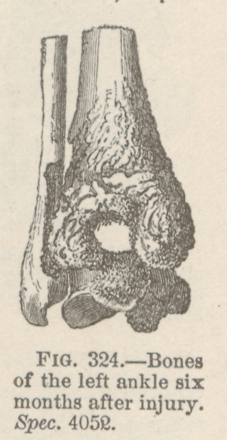Title: Dietz, D.
Source text: The Medical and Surgical History of the War of the Rebellion. (1861-65.), Part 3, Volume 2 (Washington, DC: Government Printing Office, 1883), 551.
Civil War Washington ID: med.d2e21236
TEI/XML: med.d2e21236.xml
CASE 801.—Private D. Dietz, Co. B, 48th Pennsylvania, aged 21 years, was wounded in the left ankle joint, at Spottsylvania, May 12, 1864. He remained at a field hospital for two weeks and was then conveyed to Washington, where he was admitted to Campbell Hospital. Surgeon A. F. Sheldon, U. S. V., contributed the pathological specimen, No. 4032, represented in the annexed wood-cut (FIG. 324), with the following history of the injury: "A musket ball entered the left foot posteriorly, passed forward between the astragalus and tibia, and emerged anteriorly, opposite the point of entrance, fracturing the articulating surfaces of both bones. Circular amputation through the inferior third of the leg was performed by Assistant Surgeon A. Delany, U. S. V., on November 10th, two ligatures being applied and anæsthesia produced by chloroform. At the time of the operation the foot and ankle were enlarged, with numerous openings discharging sanguinolent pus. Hectic irritation, pain, and loss of appetite were rapidly overcoming what little vitality remained. The patient bore the operation well." The patient was subsequently transferred to Judiciary Square Hospital for the purpose of being fitted with an artificial limb, and on May 19, 1865, he was discharged from service and pensioned. In his application for commutation, dated 1870, he described the stump as "healed and well," and subsequently he reported it as being in "good condition." The pensioner was paid June 4, 1880. The specimen consists of the bones comprising the ankle of the amputated leg, and shows that large quantities of spongy new bone were thrown out around the tibia, but the bodies of the bones were destroyed by suppuration.
